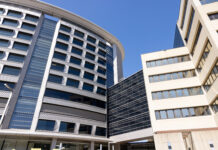by Gigi Wood
CORALVILLE – It’s about time.
The state’s public laboratory is moving in June from a 93-year-old former tuberculosis hospital to a newly constructed space designed for modern clinical testing.
The University Hygienic Laboratory is called upon to conduct a variety of public health tests for the entire state. When a baby is born, when a flood hits, when a disease outbreak spreads, the lab is an important player in the process. Lab clinicians perform prenatal mother screenings, test air and water for contaminants, identify the sources of disease outbreaks and analyze specimens for biohazards and other risks.
Right now, Iowa clinicians perform that work in the nation’s oldest hygienic lab; the state spends $1.7 million annually on operations and maintenance costs for the building.
“We have to become more dynamic,” said Christopher Atchison, director of the laboratory. “I think public health generally is going to be looking at how the environmental sciences interface with human health effects.”
Members of the Board of Regents last week toured the new lab facility at the southeast corner of Highway 965 and Oakdale Boulevard, on the University of Iowa’s Research Park. UI officials will host a ribbon cutting at the facility May 5.
The new building cost $37.75 million to construct and equip, paid for mostly with state appropriations, at $36 million, federal grants and lab revenue. What taxpayers will get in return is a facility that allows for increased security, efficiency and collaboration.
The 113,500-square-foot building is mostly replacement space and will improve the lab’s ability to handle infectious disease outbreaks, protect a part of Iowa’s homeland security infrastructure, provide greater access to information and faster responses, allow for greater efficiency to better deal with declining appropriations and augment relationships with state and federal agencies.
The laboratory employs about 250 workers and operates with a $20 million budget and contracts with a range of agencies.
UI officials will seek platinum LEED (Leadership in Energy and Environmental Design) status for the environmentally friendly building. The structure combines lab needs with green features in a building that needs to be secure during emergencies. Large windows enclose the building, letting in an abundance of natural light. While visually appealing and a nice perk for employees, those windows are also safe, with the ability to withstand winds up to 90 mph. Refrigerators and freezers housing test samples will be grouped together in rooms to maximize energy efficiency, as well.
Compared to the current building, which is south of Oakdale Boulevard down a long and winding road, the new building will be much easier to find.
“If you’re familiar with the existing lab, there are signs that sort of point you towards the woods and drive until you’re lost and then you turn back until you find the building,” Mr. Atchison said.
The new building is designed for heightened bio-security, with a new restricted-access receiving area for specimen delivery. The lab receives all types of samples and specimens from across the state, whether it is an animal suspected of having rabies, water samples or objects of unknown origin.
“This centralizes all the receiving for the building,” he said. “(Where you take specimens now) it’s a back loading dock.”
Lab staff will now be able to accept shipments in a larger area with more room to improve security measures. The lab follows CBRNE (Chemical, Biological, Radiological, Nuclear, high-yield Explosives) protocols to handle any potential threat.
“If it’s something that we don’t know what it is, we’ll be able to take it into a highly secure laboratory facility and determine what its nature is and appropriately deal with it, whereas now it gets packaged up and taken some place, but we really don’t know what it is and people are wandering around,” Mr. Atchison said. “The (new) receiving area allows us to handle anything that comes in immediately whereas before we had to take extra steps to deal with it.”
The second floor of the building includes row after row of lab workstations with adjustable counters and shelves to accommodate various sizes of equipment next to customized laboratory fume hoods. Adjacent to those work stations is a series of Biosafety Level 2 and 3 enclosed laboratories with specialized ventilation systems to keep out contaminants. The highest level of security is 4, as specified by the U.S. Centers for Disease Control and Prevention.
“At the current lab we have on lab that’s BSL-3, so any functions that require that level of service have to swap the space and now we’re going to be dealing with multiple spaces so we can begin to discriminate between TB (tuberculosis) and other things that might need a BSL-3,” he said.
The increased lab space and higher security could translate into increased partnerships between the lab and UI’s medical campus, he said.
“When you’re talking about translational research, trying to take the stuff from downtown that’s cutting edge and say, ‘let’s see if we can put this into clinical practice, because we’re a clinical lab,’” he said. “We really do want to partner with people, organizations, with business, with the Corridor. It really is vitally important, not just to the region but to the state’s economy.”
Lab operations will become more efficient in the new building, compared to the current building which is made up of a patchwork of walled-off spaces.
“It’s going to be so much easier,” said Pam Kostle, program manager at the lab who is coordinating the new facility. “You’ll actually be able to physically see people so if you somebody who needs help, you can go help them out.”
Architecturally speaking, the lab’s atrium faces the atrium of the UI BioVentures Center across Oakdale Boulevard, so the buildings are “talking” to each other. Collaborations and joint events will likely take place between the two facilities, he said. At the current lab, the adjacent Oakdale Hall is used for meeting space. The hall will be torn down after lab staff move into the new space, so the new lab will pick up some of that meeting-space slack. Mr. Atchison would also like to see science fairs and symposiums hosted in the shared spaces.
“I think it’s going to be a very nice feature in an area that obviously has a business purpose but I think it’s also something that is welcoming of the lab,” he said.
The basement level will include an employee break area, an archive library, warehouse and BSL-3 training space. Hygienic Lab officials are searching for a corporate partner to help them finish a room for a training lab that can be used by start-ups, students or others to conduct research and learn how to use equipment.




